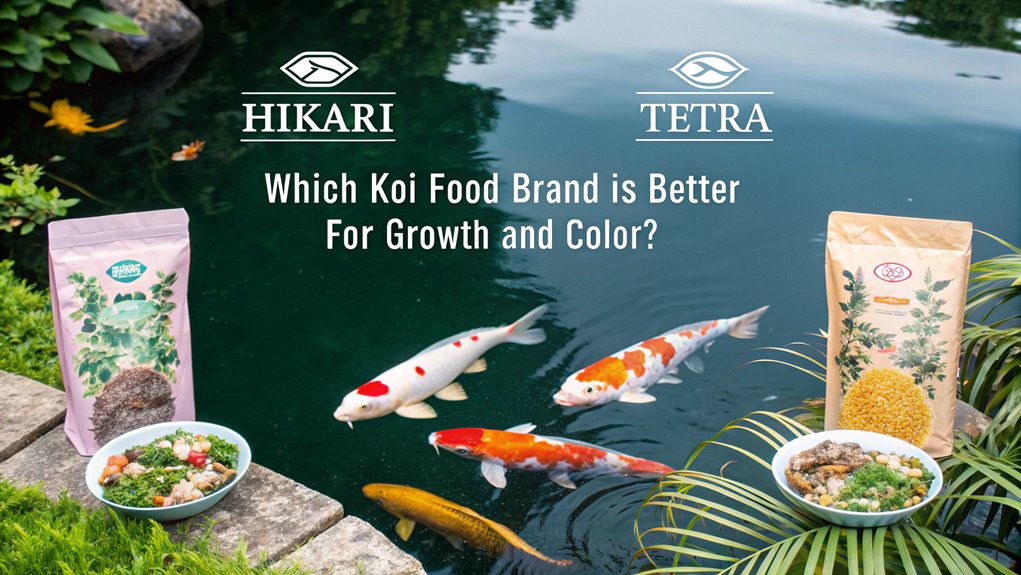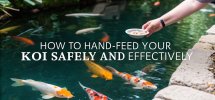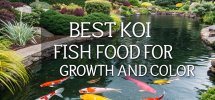Choosing between Hikari and Tetra for koi growth and color? Hikari, with 50% crude protein, surpasses Tetra’s 47.5%, offering premium nutrition. Ingredients like spirulina and krill meal in Hikari enhance digestion and color vibrancy. Although Tetra is cost-effective at $0.55 per ounce, serious aquarists might favor Hikari for its superior quality, despite its $2 per ounce price. If you’re interested in understanding these distinctions further, you’ll be equipped for a well-informed decision.
Key Facts Summarized
- Hikari offers 50% protein, promoting more effective koi growth than Tetra’s 47.5%.
- Spirulina in Hikari enhances color vibrancy, giving it an edge over Tetra.
- Hikari’s superior nutritional content justifies its higher price for serious aquarists.
- Tetra is more cost-effective, providing a balanced diet at $0.55 per ounce.
- Slow-sinking Tetra ColorBits increase feeding activity, influencing koi behavior.
Nutritional Content Comparison

When evaluating koi food brands, understanding their nutritional content is crucial for ensuring optimal koi health.
Hikari boasts a minimum of 50% crude protein, slightly surpassing Tetra’s 47.5%, potentially offering an edge in growth rate. Both feature a crude fat content of 6%, meeting koi’s energy needs effectively.
However, Hikari’s maximum crude fiber of 5% may influence digestibility compared to Tetra’s 2%. For color enhancement, Hikari includes spirulina and a carotenoid fortifier, while Tetra utilizes fish and algae meals, providing a balanced diet rich in vitamins and minerals.
Notably, Tetra specifies 1.5% phosphorus, important for meeting various nutritional needs, whereas Hikari does not. Each brand offers distinct advantages, demanding careful consideration for your koi’s dietary regimen. Additionally, premium koi food can significantly increase growth rates and maximize your koi’s potential.
Ingredient Analysis and Benefits
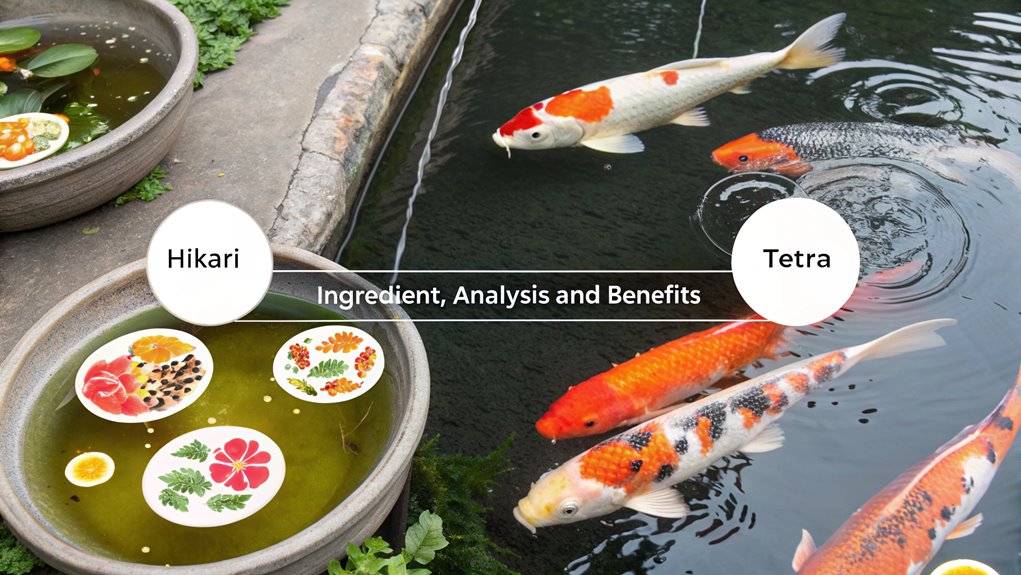
Having explored the nutritional profiles, we now focus on analyzing the ingredients and their benefits.
Hikari koi food boasts an impressive ingredient list, featuring fish meal, krill meal, spirulina, and a carotenoid fortifier. This combination not only enhances growth with a higher protein content but also boosts color vibrancy through the inclusion of spirulina and carotenoids.
On the other hand, Tetra uses fish meal, dehulled soybean meal, and wheat germ meal, providing a solid nutritional composition at a more economical price. Although it offers slightly less protein, it still supports adequate growth and color enhancement.
- Hikari’s premium protein sources drive growth
- Color enhancement from Hikari’s carotenoids
- Tetra’s cost-effective yet nutritious composition
- Spirulina in Hikari promotes vibrant colors
- Fish meal as a key component in both brands
Additionally, it is crucial to consider the impact of proper Koi nutrition on their overall health and longevity.
Cost Efficiency and Value
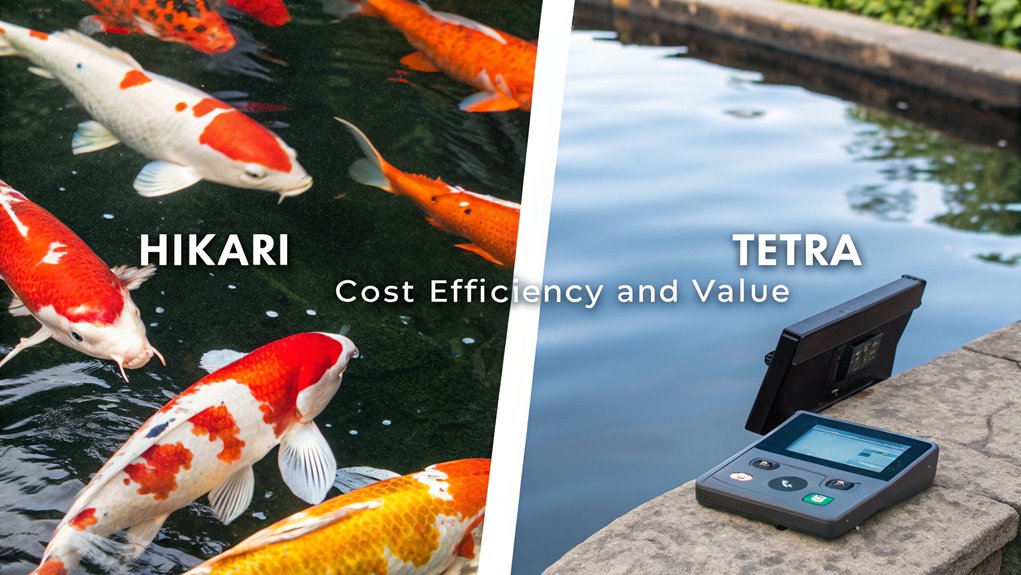
Although koi keepers often prioritize nutritional quality, cost efficiency is an equally crucial factor when selecting koi food. The choice between Hikari and Tetra brands includes analyzing cost and nutritional content.
Hikari, priced at $2 per ounce, offers a slightly superior nutritional content with 50% crude protein, benefiting Premium Koi Fish health and color. On the other hand, Tetra provides a budget-friendly option at $0.55 per ounce, with 47.5% protein, ensuring a balanced diet without a hefty price.
For koi enthusiasts prioritizing cost efficiency, Tetra’s lower price may be appealing while still maintaining adequate feeding. However, serious aquarists might justify Hikari’s higher cost due to its enhanced color benefits, despite the price difference impacting feeding choices.
Feeding Preferences and Behavior
In evaluating feeding preferences and behavior among koi and other fish, one must consider the sinking rates and textures of food options like Hikari and Tetra. Feeding your koi fish the right, high-quality food is essential.
Tetra ColorBits encourage more feeding activity due to their slower sinking, enhancing interaction and allowing for better feeding frequency. In contrast, Hikari pellets drop quickly, which might result in less feeding.
Both brands provide essential nutrients for overall health, but Hikari’s food contains color-enhancing properties. However, the strong smell of uneaten Hikari pellets can deter fish, impacting healthy growth, especially as metabolism slows. Additionally, consistent observation of koi during feeding provides insights into their behavior and preferences.
Ensure that:
- You choose food that enhances color.
- Interaction during feeding is encouraged.
- Food contains adequate protein to support growth.
- Feeding frequency is adjusted to behavior.
- Unpleasant odors are minimized.
Impact on Koi Growth
When considering the impact on koi growth, it’s vital to analyze the nutritional content and ingredient quality of their food.
Hikari offers a superior nutritional profile with a minimum of 50% crude protein compared to Tetra’s 47.5%. This higher protein content supports koi growth more effectively. Additionally, Hikari includes krill meal and spirulina, enhancing digestibility and nutrient absorption, which can lead to faster growth rates.
While Tetra focuses on palatability, affecting feeding behavior, Hikari’s high-quality ingredients provide long-term growth benefits.
For seasonal feeding, choosing the best food is crucial. Although Tetra may be more cost-effective, investing in Hikari could be worthwhile for serious koi keepers aiming for optimal growth and potential color enhancement.
Feed your Koi wisely.
Color Enhancement Effectiveness
While evaluating the effectiveness of color enhancement in koi food, it’s essential to consider the concentration and types of color-enhancing ingredients present.
Hikari koi foods boast a higher concentration of spirulina and carotenoid fortifiers, leading to remarkable color vibrancy, particularly in reds and oranges.
In contrast, Tetra relies on marigold extract and other natural color enhancers, offering a more budget-friendly option.
However, research shows Hikari’s nutritional profile, with its 50% minimum crude protein and effective digestibility, provides superior support for growth and color enhancement.
This results in koi with more pronounced reds and whites.
- Hikari’s advantage in color vibrancy
- Tetra’s cost-effective approach
- Superior digestibility in Hikari
- Spirulina’s role in natural enhancement
- Pronounced color improvements with Hikari
Frequently Asked Questions
What Is the Best Food for Koi Fish for Color and Growth?
You’d want a food with high protein and carotenoids for koi color and growth. Hikari’s higher protein and spirulina content boost both areas effectively. Ensure you manage uneaten food to prevent water quality issues.
Is Hikari the Best Koi Food?
With Hikari’s 50% crude protein, you’ve got a scientifically-backed option for optimal koi growth. Its color-enhancing ingredients like krill meal lead to vibrant fish. While pricier, the nutritional benefits can justify the investment for koi enthusiasts.
What Food Makes Koi Grow Faster?
You should choose a koi food with high protein content, like Hikari Saki Growth, for faster growth. It contains 50% protein and live microorganisms, which enhance digestion and nutrient absorption, promoting rapid muscle development and overall growth.
Is Tetra Koi Food Good?
Think of Tetra Koi Food as a reliable engine, driving your koi’s growth and vitality with its 47.5% protein. It balances nutrition with affordability, ensuring your aquatic companions thrive without straining your budget.
Conclusion
When choosing between Hikari and Tetra for your koi, think of it as choosing the fuel for a race car. Hikari offers a nutrient-rich mix, enhancing growth and vibrant color, while Tetra provides a cost-effective option with decent benefits. Hikari’s higher-quality ingredients lead to better growth and color enhancement, though at a higher cost. Ultimately, your decision should weigh these factors, aiming for a balance that best suits your koi’s health and your budget.
